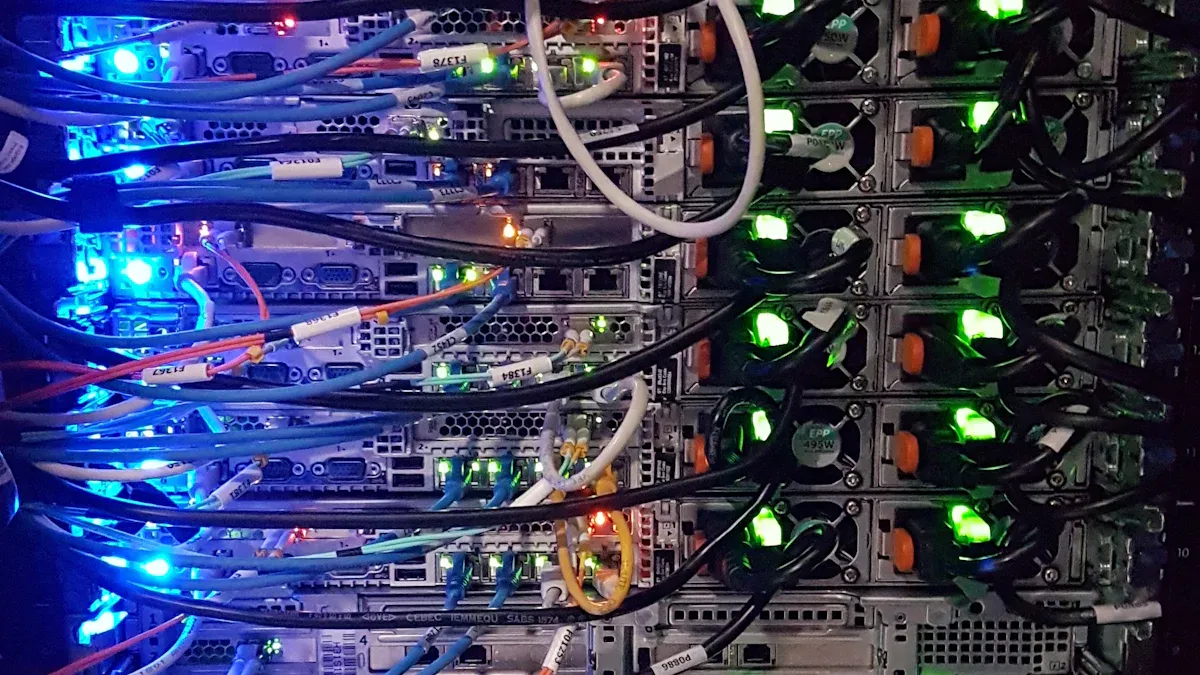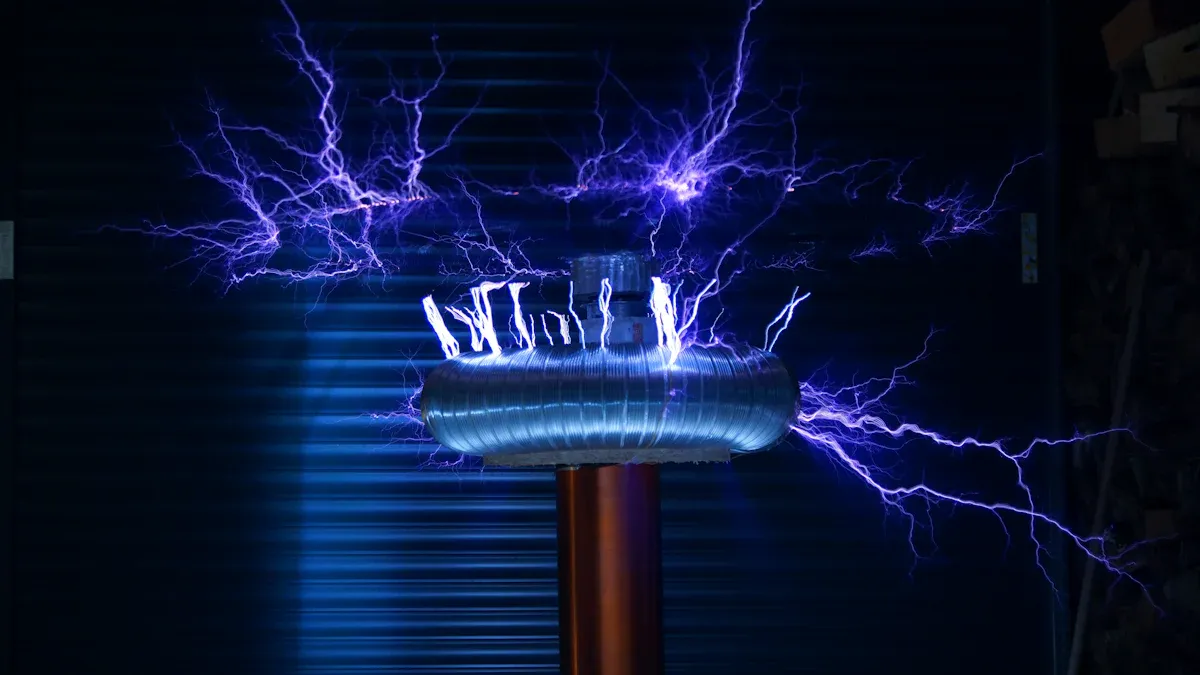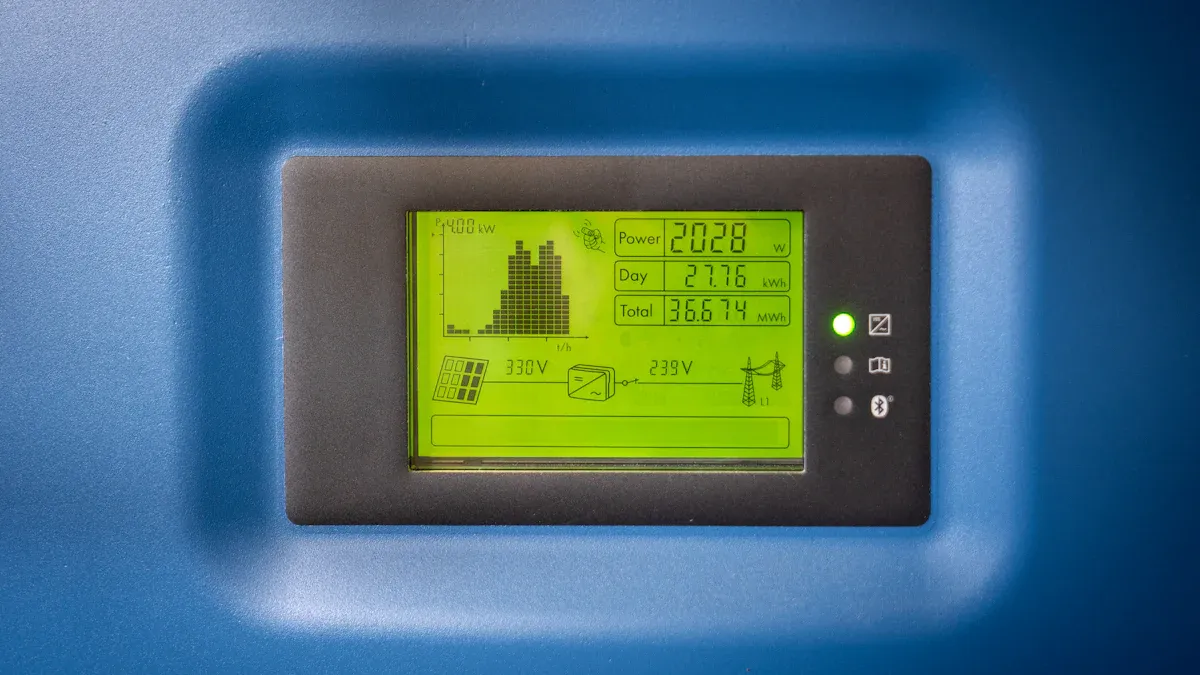Why ESTEL Rectifier Modules Matter in Power Systems

In modern electrical systems, rectifier modules play a critical role. They convert alternating current (AC) into direct current (DC), ensuring a stable dc output for your power needs. Without this conversion, many electrical devices and power supplies would fail to operate efficiently. A reliable rectifier ensures consistent performance and protects your system from interruptions.
ESTEL rectifier modules stand out due to their advanced design. They offer superior reliability and energy efficiency, making them an essential component in powering various electrical applications. These modules deliver a steady power supply, supporting both small-scale and large-scale systems with ease.
Key Takeaways
Rectifier modules change AC power into steady DC power. This is important for devices like computers and solar energy systems.
ESTEL rectifier modules work efficiently, saving energy and lowering costs. This makes them a good option for businesses.
Their modular design makes upgrades and repairs simple. Systems can adjust to new power needs without big problems.
Smart features like AI help monitor systems in real-time. This improves reliability and reduces downtime for important uses.
Picking ESTEL rectifiers means using trusted technology. It helps save energy and manage power better.
Understanding Rectifier Modules

What Are Rectifier Modules?
Rectifier modules are essential components in modern electrical systems. They convert alternating current (AC) into direct current (DC), which is a more stable and consistent form of power. These modules are widely used in applications where DC power is required, such as telecommunications, industrial equipment, and renewable energy systems. By ensuring a smooth and reliable power supply, rectifier modules help maintain the efficiency and functionality of your electrical devices.
The global rectifier market reflects the growing importance of these modules. According to recent data, the market size is projected to grow from USD 6.92 billion in 2024 to USD 9.75 billion by 2032, with a compound annual growth rate (CAGR) of 4.42%. This growth is driven by the increasing demand for energy-efficient power conversion solutions across various industries.
The Process of Rectification
Rectification is the process of converting AC into DC. AC power alternates its direction periodically, while DC flows in a single, consistent direction. Rectifiers achieve this conversion by using components like diodes, which allow current to flow in only one direction. This process eliminates the alternating nature of AC, resulting in a steady DC output.
There are two main types of rectification: half-wave and full-wave. Half-wave rectification uses only one half of the AC cycle, while full-wave rectification utilizes both halves, making it more efficient. Modern rectifier modules often employ advanced technologies, such as silicon carbide (SiC) and gallium nitride (GaN), to enhance performance and reduce energy losses. These advancements are particularly beneficial in applications like telecommunications and electric vehicles, where reliable and efficient power conversion is critical.
Metric | Description | Importance in Rectifiers |
|---|---|---|
Ripple | Measurement of the clarity of power, expressed as a percentage. | Indicates efficiency and quality of rectification. |
Voltage Applied | The voltage level that the rectifier is designed to handle. | Critical for ensuring proper operation. |
Current Needed | The amount of current required for the specific application. | Determines the rectifier's capacity. |
Why DC Power Is Essential
DC power plays a crucial role in modern electrical systems. Many devices, such as computers, smartphones, and LED lighting, operate on DC. It provides a stable and consistent energy source, which is vital for sensitive electronics. Unlike AC, DC does not experience fluctuations, making it ideal for applications that require precision and reliability.
In renewable energy systems, DC power is indispensable. Solar panels and batteries generate and store energy in DC form. Rectifier modules ensure that this energy can be efficiently converted and utilized. Additionally, the rise of electric vehicles has further highlighted the importance of DC power. High-performance rectifiers enable reliable power flow, ensuring the smooth operation of these vehicles.
The efficiency improvements offered by rectifier modules are evident across various sectors:
Application Sector | Efficiency Improvement Impact |
|---|---|
Telecommunications | Increased demand for energy-efficient power conversion |
Industrial Power Supplies | Essential for reliable DC power from AC sources |
Electric Vehicles | Adoption of high-performance rectifiers for reliable power flow |
As industries continue to adopt advanced technologies, the demand for efficient rectification will only grow. By understanding the importance of DC power and the role of rectifier modules, you can appreciate their impact on modern electrical systems.
Benefits of Rectifier Modules in Power Systems
Ensuring Stability and Reliability
Rectifier modules play a vital role in maintaining the stability of your electrical systems. They ensure a stable DC output, which is crucial for sensitive devices like telecommunications equipment and industrial machinery. Without a reliable rectifier, fluctuations in voltage or current could disrupt operations or damage your equipment. These modules regulate the power supply, providing consistent performance even during sudden changes in input power.
The reliability of rectifier modules also minimizes downtime. By delivering a steady power supply, they protect your system from unexpected interruptions. This feature is especially important in critical applications, such as data centers and hospitals, where even a brief power failure can have significant consequences.
Enhancing Energy Efficiency
Energy efficiency is a key advantage of modern rectifier modules. They convert AC to DC with minimal energy loss, ensuring that your systems operate at peak performance. Advanced technologies, such as silicon carbide (SiC) components, further enhance efficiency by reducing heat generation and power wastage. This improvement not only lowers operational costs but also supports sustainability by reducing energy consumption.
Efficient rectifiers also help maintain optimal voltage and current levels. By minimizing energy losses, they ensure that your electrical devices receive the precise power they need. This precision enhances the overall efficiency of your power systems, making them more cost-effective and environmentally friendly.
Supporting Scalability and Flexibility
Modern rectifier modules are designed with scalability and flexibility in mind. Their modular architecture allows you to add or remove units as needed, making it easy to adapt to changing power demands. This feature is particularly beneficial for expanding telecom networks, especially with the growing adoption of 5G infrastructure. As power requirements increase, you can scale your system without overhauling the entire setup.
The plug-and-play design of these rectifiers simplifies maintenance and reduces downtime. You can replace or upgrade individual modules without disrupting the entire system. This adaptability makes rectifier modules an ideal choice for dynamic environments, where power needs can change rapidly.
ESTEL Rectifier Modules: A Superior Choice
Advanced Features and Technology
ESTEL rectifier modules stand out due to their cutting-edge technology and innovative features. These modules integrate advanced AI and IoT capabilities, enabling real-time monitoring and predictive maintenance. This ensures your systems operate at peak efficiency while minimizing downtime. For example, AI-driven analytics allow the rectifier to self-optimize based on usage patterns, reducing the need for frequent manual adjustments.
The patented zero-voltage switching hybrid voltage divider is another technological breakthrough. This innovation significantly improves energy conversion efficiency, reducing operational costs and supporting sustainable practices. Additionally, ESTEL’s zero current and zero voltage technology minimizes energy loss during AC to DC conversion. This ensures a stable DC output, which is essential for critical applications like telecommunications and industrial automation.
Innovation Type | Description |
|---|---|
AI and IoT Integration | Enhances operational efficiency through predictive maintenance and real-time monitoring, optimizing performance. |
Power Conversion Technology | A patented zero-voltage switching hybrid voltage divider improves energy conversion efficiency, reducing operational costs. |
Zero Current and Zero Voltage Tech | Minimizes energy loss during AC to DC conversion, achieving over 90% efficiency, supporting sustainable telecom operations. |
These advanced features make ESTEL rectifiers a reliable choice for modern electrical systems. Whether you need a stable DC output for telecommunications or efficient power supplies for industrial equipment, these modules deliver unmatched performance.
Proven Track Record in Reliability
Reliability is a hallmark of ESTEL rectifier modules. Their robust design ensures consistent performance even in demanding environments. These modules maintain a stable DC output, protecting your electrical systems from fluctuations in voltage or current. This reliability minimizes the risk of downtime, which is critical for applications like data centers and hospitals.
Comparative performance statistics further highlight ESTEL’s superiority. With conversion efficiency exceeding 98%, these rectifiers outperform competitors, whose efficiency typically ranges between 94% and 96%. ESTEL’s ultra-modular designs also provide greater flexibility, allowing you to scale your system as needed. Additionally, their AI integration offers predictive analytics and self-optimization, features that are often absent in competing products.
Feature | ESTEL’s Delta Rectifier Modules | Competitors’ Modules |
|---|---|---|
Modularity | Ultra-modular designs | Limited modular options |
AI Integration | Predictive analytics & self-optimization | Basic AI capabilities |
Conversion Efficiency | >98% | 94–96% |
Applications | Automotive, hybrid vehicles, industrial automation solutions | Primarily automotive |
By choosing ESTEL rectifiers, you gain access to a proven solution that ensures reliability and efficiency across various applications.
Tailored Solutions and Customer Support
ESTEL doesn’t just offer rectifier modules; it provides rectifier solutions tailored to your specific needs. Whether you require a compact design for a small-scale system or a high-capacity module for industrial power supplies, ESTEL has you covered. Their modular architecture allows for easy upgrades, ensuring your system can adapt to changing power demands.
Customer support is another area where ESTEL excels. Their team provides comprehensive assistance, from installation to ongoing rectifier maintenance. This ensures your power systems remain operational with minimal disruptions. If you need to replace or upgrade a module, ESTEL’s plug-and-play design simplifies the process, reducing downtime and maintenance costs.
With ESTEL, you’re not just investing in advanced technology; you’re partnering with a company committed to your success. Their tailored solutions and exceptional support make them a trusted choice for businesses worldwide.
Applications of ESTEL Rectifier Modules

Telecommunications Infrastructure
ESTEL rectifier modules play a vital role in telecommunications. They ensure uninterrupted power for communication networks, even in remote or challenging environments. For example, GreenConnect, a telecom company, faced high energy costs and carbon emissions from diesel generators. By installing ESTEL’s renewable-ready rectifiers at 500 remote sites, they integrated solar and wind energy into their systems. This solution reduced energy use by 30%, cut CO2 emissions by 40%, and minimized downtime by 25%.
These rectifiers also feature IoT-enabled technology, which allows real-time monitoring and predictive maintenance. With a power factor of 0.99 and 95% efficiency, they minimize energy waste while ensuring stable power delivery. This reliability is critical for maintaining seamless communication, especially in emergencies or high-demand scenarios.
Industrial Power Systems
In industrial settings, ESTEL rectifiers enhance efficiency and reliability. Their robust design supports heavy-duty applications, such as manufacturing and automation. These industrial rectifiers operate within a wide input voltage range of 90–280 Vac and maintain a high output efficiency of up to 92%. This ensures consistent power delivery, even under fluctuating load conditions.
The modular architecture of these rectifiers simplifies upgrades and maintenance. You can easily replace or expand modules without disrupting operations. This flexibility makes them ideal for dynamic industrial environments where power demands frequently change. Additionally, their low ripple voltage ensures stable electrical output, protecting sensitive equipment from damage.
Parameter | Typical Value | Unit |
|---|---|---|
Input Voltage Range | 220 | Vac |
Output Efficiency | 92 | % |
Operating Temperature | -25 to +55 | °C |
Renewable Energy Integration
ESTEL rectifier modules are designed to integrate seamlessly with renewable energy systems. They achieve peak efficiency of 97.83% at 277 Vac, minimizing energy losses and reducing operational costs. These rectifiers maintain stable power output, even under variable conditions, making them ideal for solar and wind power applications.
Sustainability is a key focus of ESTEL’s design. High-efficiency converters reduce energy waste, supporting eco-friendly initiatives. By ensuring stable power delivery, these rectifiers help you maximize the potential of renewable energy sources. Their advanced technology also supports long-term performance, reducing the need for frequent maintenance or upgrades.
Rectifier modules are essential for ensuring stable and efficient power conversion in modern electrical systems. They provide reliable DC power, which is critical for sensitive devices and renewable energy systems. Metrics like Peak Inverse Voltage (PIV) and Ripple Factor highlight their ability to deliver high-quality output and prevent failures. ESTEL rectifier modules excel with advanced technology, offering unmatched reliability and adaptability. Their modular design simplifies maintenance and supports seamless upgrades, making them a trusted choice across industries. By choosing ESTEL, you ensure your systems remain efficient and future-ready.
Metric | Description |
|---|---|
Peak Inverse Voltage (PIV) | Ensures diodes do not exceed voltage ratings, preventing failure and ensuring reliability. |
Ripple Factor | Measures fluctuations in the rectified DC output, indicating the quality of the output voltage. |
Transformer Utilization Factor (TUF) | Ratio of DC power output to AC rating of the output coil, indicating circuit efficiency. |
FAQ
What makes ESTEL rectifier modules different from others?
ESTEL rectifier modules stand out due to their advanced technology, including AI integration and zero-voltage switching. These features enhance efficiency and reliability. Their modular design also allows easy scalability and maintenance, making them a superior choice for various industries.
Can ESTEL rectifier modules handle renewable energy systems?
Yes! ESTEL rectifiers integrate seamlessly with renewable energy sources like solar and wind. They achieve high efficiency (up to 97.83%) and ensure stable power output, even under fluctuating conditions. This makes them ideal for eco-friendly and sustainable energy solutions. 🌱
How do rectifier modules improve energy efficiency?
Rectifier modules convert AC to DC with minimal energy loss. ESTEL modules use advanced components like silicon carbide (SiC) to reduce heat generation and power wastage. This ensures your systems operate efficiently, lowering energy costs and supporting sustainability.
Are ESTEL rectifier modules easy to maintain?
Absolutely! ESTEL modules feature a plug-and-play design, simplifying maintenance and upgrades. You can replace or expand modules without disrupting operations. This flexibility reduces downtime and ensures your system remains operational with minimal effort.
Where can I use ESTEL rectifier modules?
You can use ESTEL rectifier modules in telecommunications, industrial power systems, and renewable energy integration. Their robust design and high efficiency make them suitable for critical applications like data centers, hospitals, and manufacturing facilities.
💡 Tip: Always consult ESTEL’s customer support for tailored solutions to meet your specific power needs.
See Also
Ensuring Correct Voltage Levels in ESTEL Communication Cabinets
Understanding the Power System of ESTEL Telecom Cabinets
A Detailed Overview of Telecom Cabinet Battery Risk Analysis
Exploring the Function of ESTEL PDUs in Data Centers
Utilizing Energy Storage Solutions for ESTEL Telecom Cabinets
CALL US DIRECTLY
86-13752765943
3A-8, SHUIWAN 1979 SQUARE (PHASE II), NO.111, TAIZI ROAD,SHUIWAN COMMUNITY, ZHAOSHANG STREET, NANSHAN DISTRICT, SHENZHEN, GUANGDONG, CHINA


